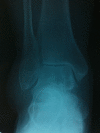[Villonodular synovitis of the ankle, an uncommon location: a case report]
- PMID: 27231502
- PMCID: PMC4867721
- DOI: 10.11604/pamj.2016.23.90.8838
[Villonodular synovitis of the ankle, an uncommon location: a case report]
Abstract
Pigmented villonodular synovitis (PVNS) is a rare pseudotumoral proliferative benign condition of unknown etiology, affecting synovial joints. It can also develop in the synovial bursae and in the tendon sheaths. It usually affects large joints, such as the knee and the hip. Ankle is a rare location, with only a few cases reported in the literature. We report a case of a 52 year old patient with a PVS of the right ankle. She received a subtotal synovectomy. After 2 years of follow-up there was no clinical recurrence.
La synovite villonodulaire (SVN) est une prolifération pseudotumorale bénigne rare de la synoviale articulaire, d’étiologie inconnue. Elle peut aussi se développer au sein des bourses séreuses, des gaines tendineuses. Généralement, elle atteint les grosses articulations notamment le genou et la hanche. La localisation de la cheville est rare, avec seulement quelques cas publiés dans la littérature. Nous rapportons un cas de patiente de 52 ans présentant une SVN de la cheville droite. Elle a bénéficié d'une synovectomie subtotale. A deux ans de recul, il n'y avait pas de récidive clinique.
Keywords: Villonodular synovitis; ankle; synovectomy.
Figures
Similar articles
-
Pigmented villonodular synovitis of the ankle-radiation therapy as a primary treatment to reduce recurrence: a case report with 8-year follow-up.J Foot Ankle Surg. 2011 Jan-Feb;50(1):108-16. doi: 10.1053/j.jfas.2010.10.001. J Foot Ankle Surg. 2011. PMID: 21172644 Review.
-
Localized nodular pigmented villonodular synovitis of the upper ankle joint--diagnosis and treatment.Z Rheumatol. 2006 May;65(3):231-4. doi: 10.1007/s00393-005-0008-1. Z Rheumatol. 2006. PMID: 16477454
-
Pigmented villonodular synovitis of the talonavicular joint: a case report and review of the literature.Foot (Edinb). 2009 Sep;19(3):186-8. doi: 10.1016/j.foot.2009.01.006. Epub 2009 Feb 24. Foot (Edinb). 2009. PMID: 20307474 Review.
-
[A case of pigmented villonodular synovitis of the elbow joint with bone invasion].Acta Orthop Traumatol Turc. 2006;40(2):169-72. Acta Orthop Traumatol Turc. 2006. PMID: 16757936 Turkish.
-
[Synovitis villonodosa pigmentosa of the foot--diagnosis, therapy and long-term course].Z Orthop Ihre Grenzgeb. 1988 Mar-Apr;126(2):130-7. doi: 10.1055/s-2008-1044882. Z Orthop Ihre Grenzgeb. 1988. PMID: 3407298 German.
References
-
- Tekaya R, Haouel M, Kammoun SH, et al. Synovite villonodulaire de l'articulation sub-talaire. Médecine et Chirurgie du Pied. 2011;27(4):106–108.
-
- Jaffe HL, Lichtenstein L, Sutro CJ. Pigmented villonodularsynovitis,bursitis and tenosynovitis. Archives Pathology. 1941;31(3):731–765.
-
- Myers BW, Masi AT. Pigmented villonodular synovitis and tenosynovitis: a clinical epidemiologic study of 166 cases and literature review. Medicine. 1980;59(3):223–238. - PubMed
-
- Sharma H, Rana B, Mahendra A, et al. Outcome of 17 pigmented villonodular synovitis of the knee at 6 years mean follow-up. Knee. 2007;14(5):390–4. - PubMed
-
- Murphey MD, Rhee JH, Lewis RB, et al. Pigmented villonodular synovitis: radiologic-pathologic correlation. Radiographics. 2008;28(5):1493–518. - PubMed
Publication types
MeSH terms
LinkOut - more resources
Full Text Sources
Other Literature Sources
Research Materials




